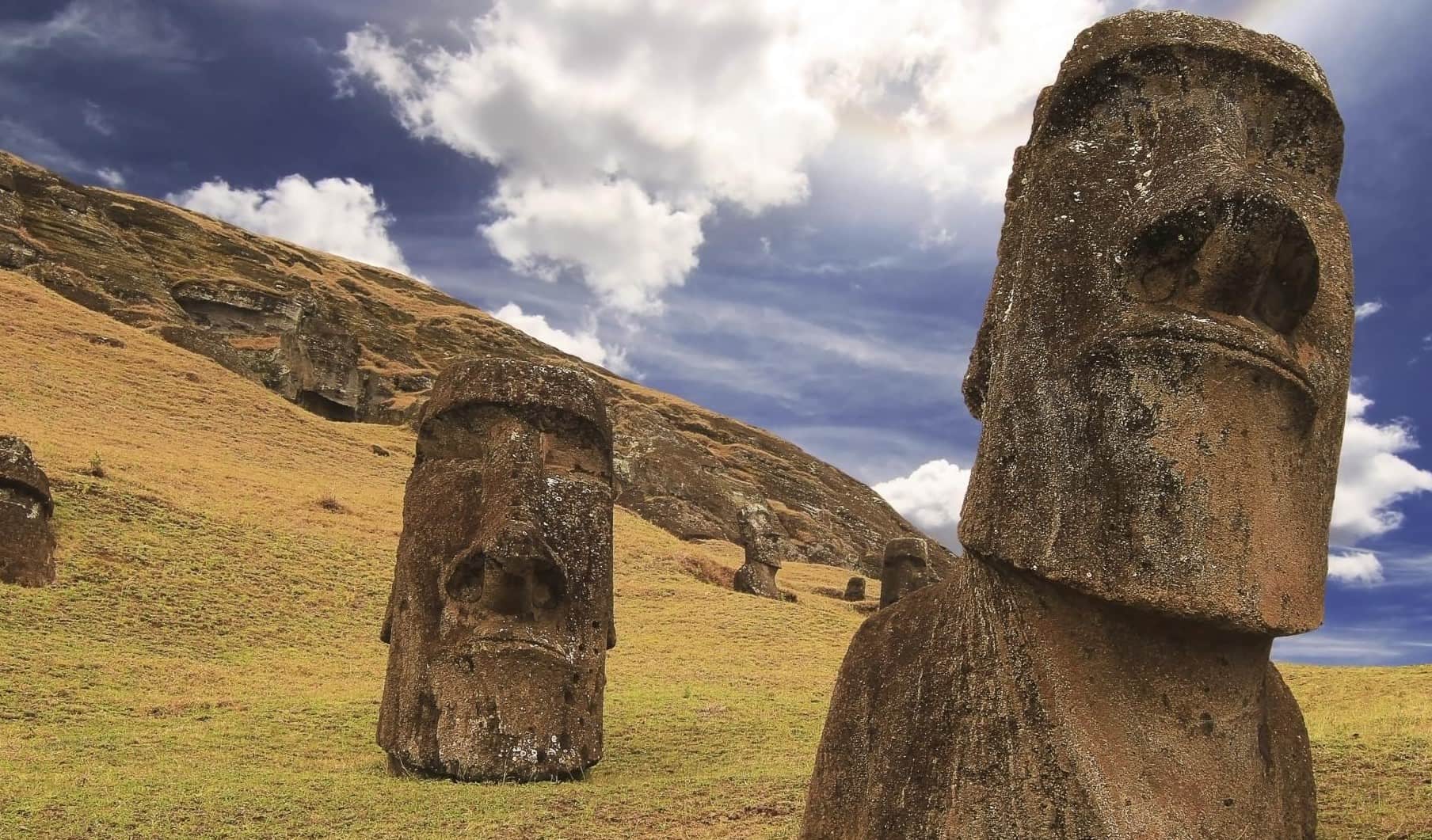
The Moai of Rapa Nui, also known as Easter Island, are one of the most enigmatic and striking landmarks in the world. These monumental stone statues have captivated the imagination of travelers and researchers alike for centuries. Located in the remote Pacific Ocean, Easter Island is renowned for its iconic stone giants, which continue to puzzle experts with their sheer size, intricate craftsmanship, and the mystery surrounding their creation. In this article, we will delve into 17 fascinating facts about the Moai of Rapa Nui, shedding light on their history, cultural significance, and the ongoing efforts to understand the secrets they hold. Join us on this journey to uncover the fascinating world of the Moai and delve into the captivating story of Easter Island’s ancient inhabitants.
Key Takeaways:
- The Moai of Rapa Nui are massive stone statues on Easter Island, each with its own unique features and history. Their purpose and the mystery surrounding them continue to intrigue and captivate people around the world.
- The preservation of the Moai is crucial to safeguarding this significant cultural heritage. Efforts to restore fallen statues and educate the public about their historical and cultural significance are ongoing, ensuring that the mystery of the Moai lives on for future generations.
The Moai are enormous stone statues.
Standing tall on the remote Easter Island, the Moai are massive stone statues crafted by the Rapa Nui people. Weighing an average of 14 tons, these monolithic figures are a testament to the ingenuity and skill of the ancient civilization.
There are over 900 Moai on Easter Island.
Easter Island is home to one of the most impressive collections of Moai in the world. In total, there are over 900 statues scattered across the island, each with its own unique characteristics and presence.
The tallest Moai stands at 33 feet.
The largest Moai on Easter Island, known as “Paro,” reaches an astounding height of 33 feet. This colossal statue not only showcases the craftsmanship of the Rapa Nui people but also stands as a symbol of their cultural legacy.
The Moai were carved from volcanic rock.
The Rapa Nui people created the Moai by chiseling them out of compressed volcanic ash called tuff. This volcanic rock provided a durable material that enabled the statues to withstand the test of time.
Transporting the Moai was a remarkable feat.
One of the most intriguing aspects of the Moai is how they were transported across the island. It is believed that the Rapa Nui people used a combination of ropes, sledges, and manpower to move these massive statues from the quarries to their designated platforms.
The purpose of the Moai is still uncertain.
While many theories exist, the precise purpose of the Moai remains a subject of speculation. Some believe they were designed to honor ancestors, while others suggest they represented tribal leaders or served a religious function.
The carving of the Moai was a sacred ritual.
The creation of a Moai was not simply a construction project; it involved religious rituals and ceremonies. The Rapa Nui people considered the statues to be vessels of powerful spirits, imbuing them with symbolic significance.
Moai construction abruptly stopped at a certain point.
Despite the impressive number of Moai on Easter Island, the carving and placement of the statues came to an abrupt halt at a particular point in history. The reason behind this mysterious ceasation remains unknown.
Ahu are the ceremonial platforms where the Moai stand.
The Moai are typically placed on large stone platforms called ahu. These platforms serve as ceremonial areas and are strategically located across the island, creating a unique and awe-inspiring landscape.
Many Moai have distinctive topknots.
Several of the Moai statues feature a distinctive appendage on their heads known as a topknot. These cylindrical stones, called pukao, were carved separately and placed atop the statues, adding to their grandeur.
The process of carving a Moai was a meticulous endeavor.
Creating a Moai required precision and skill. Carvers employed various tools, including basalt picks, stone chisels, and obsidian scrapers, to sculpt the stone and give shape to the unique facial features of each statue.
Moai have different facial expressions.
Despite the general similarity in their appearance, each Moai possesses distinct facial expressions. These variations can be seen through differences in the eyebrows, eye shape, and overall style, showcasing the individuality of each statue.
An unfinished Moai can still be found in the quarry.
At Rano Raraku, the main quarry of Easter Island, there is an unfinished Moai lying on its back. This incomplete statue offers a fascinating glimpse into the carving process and provides insight into the skill and labor involved in creating these monumental figures.
The restoration of fallen Moai has taken place.
Over time, some Moai have fallen from their platforms due to factors like natural erosion and human activities. Efforts have been made to restore and reposition these fallen statues, helping to preserve the integrity and history of the Moai for future generations.
The Moai have captivated travelers and explorers for centuries.
Since the initial encounters with Easter Island in the 18th century, explorers and travelers have been fascinated by the Moai. These enigmatic statues continue to draw visitors from around the world, igniting a sense of wonder and curiosity about their origins.
Preserving the Moai is of utmost importance.
The conservation and preservation of the Moai are crucial to safeguarding this significant cultural heritage. Various organizations and initiatives are devoted to preserving these awe-inspiring statues and educating the public about their historical and cultural significance.
The mystery of the Moai lives on.
Despite extensive research and archaeological investigations, numerous mysteries surrounding the Moai of Rapa Nui persist. The enigmatic allure of these statues continues to captivate and intrigue, reminding us of the rich and complex history of Easter Island.
Conclusion
The Moai of Rapa Nui are undoubtedly one of the most fascinating and mysterious landmarks in the world. Standing tall, these monolithic statues continue to captivate the imagination of people from all walks of life. From their impressive size to their enigmatic origins, there is much to learn and appreciate about these ancient sculptures.
Their cultural and historical significance cannot be overstated, as they provide a glimpse into the rich and complex history of the Rapa Nui civilization. The sheer effort and ingenuity required to carve and transport these massive statues is a testament to the skill and determination of the island’s inhabitants.
While many questions still remain unanswered, ongoing research and archaeological discoveries continue to shed light on the secrets of the Moai. As we continue to unravel the mysteries surrounding these impressive statues, one thing is certain: the Moai of Rapa Nui will forever remain an enduring symbol of human creativity and resilience.
FAQs
1. What is the purpose of the Moai of Rapa Nui?
The purpose of the Moai is still debated among experts. Some believe that they were carved to represent deified ancestors and protect the island, while others suggest they served as a symbol of authority for the ruling clans.
2. How were the Moai transported and erected?
The exact techniques used to transport and erect the Moai remain a mystery. It is believed that they were carved at the quarry site and then moved using a combination of sledges, ropes, and manpower. The statues were then tilted upright into final positions.
3. How many Moai are there on Rapa Nui?
There are approximately 1,000 Moai scattered across the island. Some are still in the process of being carved while others are standing upright or fallen. The largest completed Moai, known as “Paro,” is 10 meters tall and weighs around 75 tons.
4. Why are the faces of the Moai so distinct?
The Moai are believed to represent deceased ancestors. The distinct facial features, including prominent brows, hollow eye sockets, and elongated noses, are thought to symbolize the Rapa Nui people’s reverence for their lineage.
5. Can you visit the Moai of Rapa Nui?
Yes, the Moai are accessible to visitors on Rapa Nui. The most famous site, Ahu Tongariki, features 15 standing Moai and is a popular attraction. Visitors are advised to be respectful of the statues and follow guidelines to preserve their integrity.
Unraveling mysteries, marveling at human ingenuity, and exploring distant lands—the world brims with captivating stories waiting to be discovered. From the intricately carved stone sculptures of the Gomateshwara Statue to the awe-inspiring ruins of Fatehpur Sikri, a UNESCO World Heritage Site, each destination holds secrets begging to be uncovered. For those drawn to the allure of archaeology, Samarra Archaeological City beckons, promising a journey through time and civilizations long past. Embark on your next adventure, and let these fascinating tales transport you to realms beyond imagination.
Was this page helpful?
Our commitment to delivering trustworthy and engaging content is at the heart of what we do. Each fact on our site is contributed by real users like you, bringing a wealth of diverse insights and information. To ensure the highest standards of accuracy and reliability, our dedicated editors meticulously review each submission. This process guarantees that the facts we share are not only fascinating but also credible. Trust in our commitment to quality and authenticity as you explore and learn with us.


